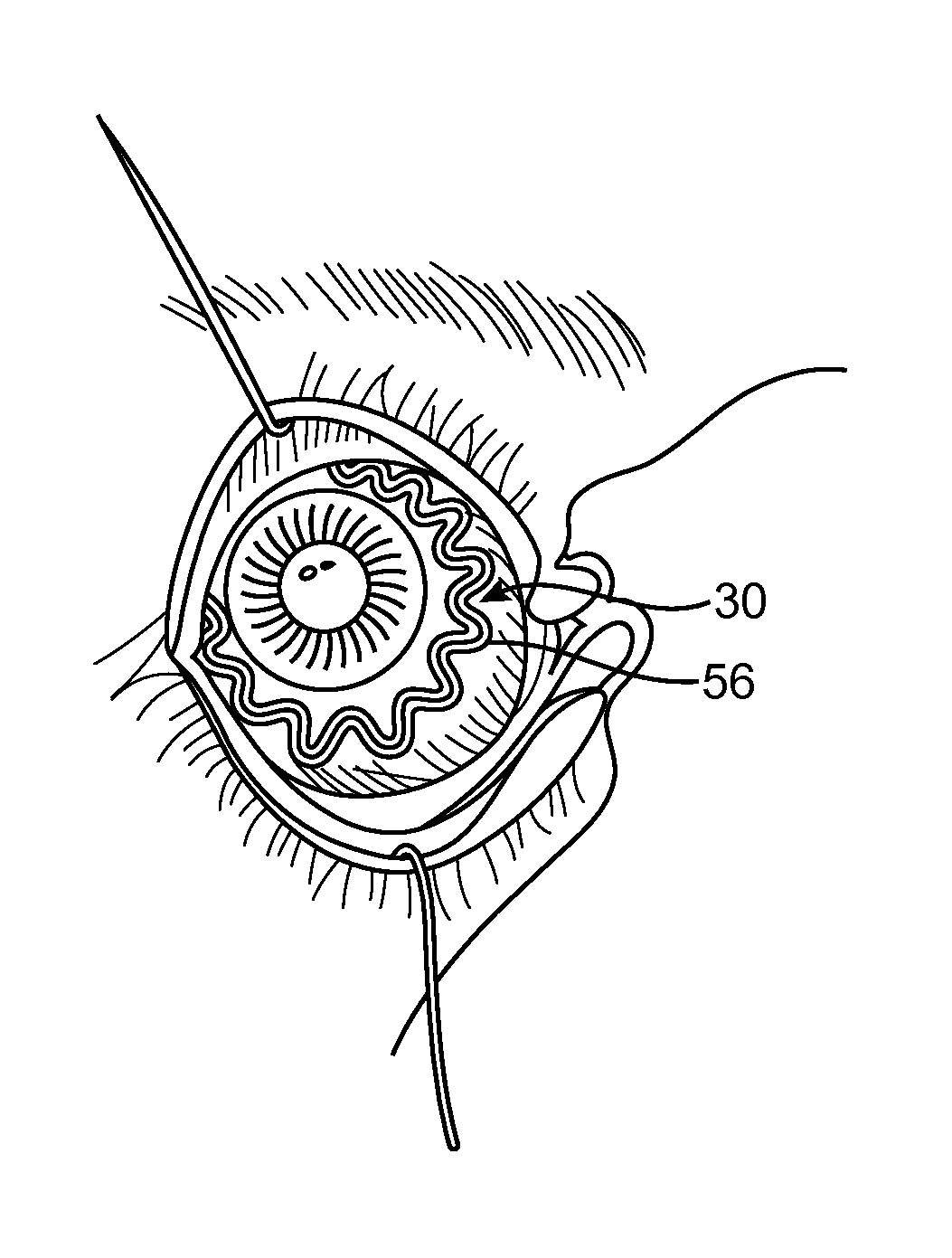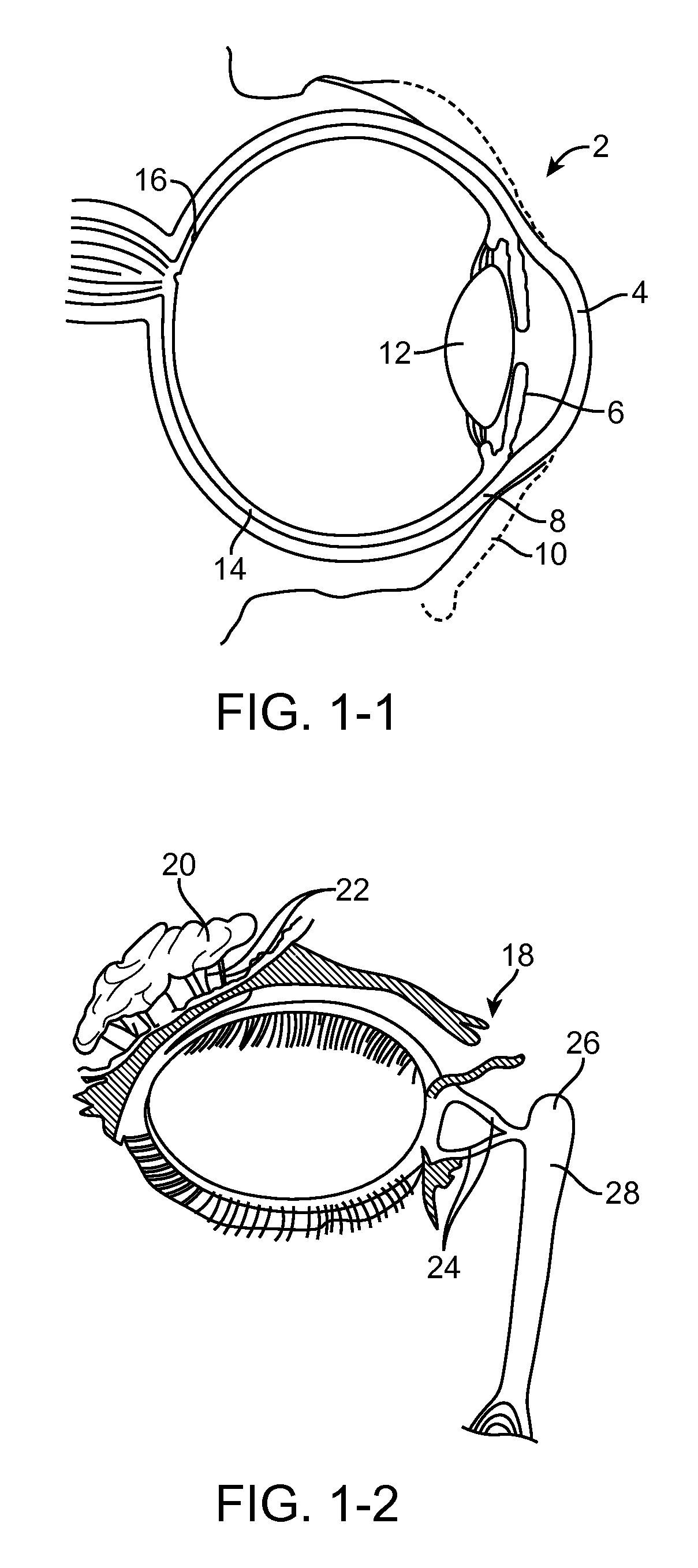Anterior segment drug delivery
a technology of anterior segment and drug delivery, which is applied in the field of anterior segment drug delivery, can solve the problems of blurring the patient's vision for a prolonged time period, the drug's presence in the bloodstream may have harmful side effects on the rest of the body, and the drug's most wasteful us
- Summary
- Abstract
- Description
- Claims
- Application Information
AI Technical Summary
Benefits of technology
Problems solved by technology
Method used
Image
Examples
example 1
Calculation of a Drug's Therapeutically Effective Dosage for an Ocular Insert—Olopatadine
[0107]The drug Olopatadine, for treatment of allergic conditions, will demonstrate a method that can be used in calculating a drug's therapeutically effective plant-delivered dosage based on a drop-administered treatment regimen for that drug. The calculation method involves the following steps: 1.) determining the number of drops desired per application; 2.) multiplying the number of drops by 30 uL (the volume of one drop); 3.) determining the amount of solid drug per uL; 4.) multiplying the results from step 2 by the result from step 3, to find out the amount of solid drug to be applied to the eye on a daily basis; 5.) multiplying the result in step 4 by the number of days of therapy desired for the particular drug; and 6) multiplying by the efficiency of drug delivery. This final amount will preferably be dispersed from an ocular insert.
[0108]Olopatadine is an ophthalmic antihistamine (H 1 -r...
example 2
Drug Delivery Procedure & Elution Rate Control for a Hydrophilic Drug—Olopatadine hydrochloride
[0110]Olopatadine HCl (OH) for ophthalmic applications can be formulated as a 0.2% (2 mg / mL) solution. A single 50 uL drop containing 100 ug of OH may be instilled in the eye once a day for 2 weeks. Estimating 5% availability, this gives a 5 ug / day dose delivered to the cornea, for a total of 70 ug over the course of the 2 week treatment. At least 70 ug in dry form could be loaded into the implant and released into the tear film by partitioning the drug reservoir with a membrane (e.g. HEMA, PVA, PVP, GMA, dialysis tubing of cellulose, etc) or embedding the drug within the implant. The release rate could be controlled by altering the surface area exposed to the tear film to tailor the desired 5 ug / day (0.21 ug / hour), by altering a drug release controlling membrane, or the like. It is again assumed in this calculation that 100% of the targeted dose gets to its target location without being w...
example 3
Drug Delivery Procedure & Elution Rate Control for a Hydrophobic Drug—Prednisolone Acetate
[0112]Generally, a 1% Prednisolone acetate suspension (10 mg / mL) is given 2 drops (total of approximately 100 uL volume) 4 times daily for a week. Working with the estimate that 5% of a dose is actually available for absorption into the cornea, this amounts to 20 ug / day of Prednisolone acetate. A week's available dose is then 140 ug. The solubility of Prednisolone acetate in aqueous solutions is approximately 240 ug / mL. At least 140 ug of solid Prednisolone acetate could be loaded into the implant, allowing the Prednisolone acetate to dissolve into the tear layer at a rate of about 0.83 ug / hour. The rate could be controlled by the porosity of the implant as well as the surface area exposed to the tear film.
[0113]For these simplified calculations, it has been assumed that 100% of the dose hits the target (the cornea) and is absorbed completely and not lost by tear layer flow away from the cornea...
PUM
| Property | Measurement | Unit |
|---|---|---|
| diameter | aaaaa | aaaaa |
| arc angle | aaaaa | aaaaa |
| diameter | aaaaa | aaaaa |
Abstract
Description
Claims
Application Information
 Login to View More
Login to View More - R&D
- Intellectual Property
- Life Sciences
- Materials
- Tech Scout
- Unparalleled Data Quality
- Higher Quality Content
- 60% Fewer Hallucinations
Browse by: Latest US Patents, China's latest patents, Technical Efficacy Thesaurus, Application Domain, Technology Topic, Popular Technical Reports.
© 2025 PatSnap. All rights reserved.Legal|Privacy policy|Modern Slavery Act Transparency Statement|Sitemap|About US| Contact US: help@patsnap.com



